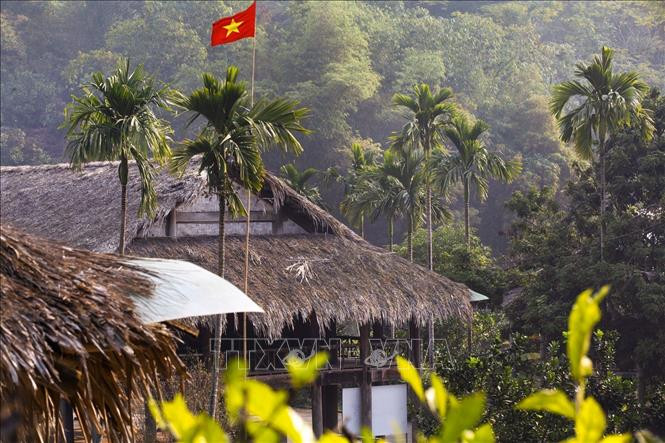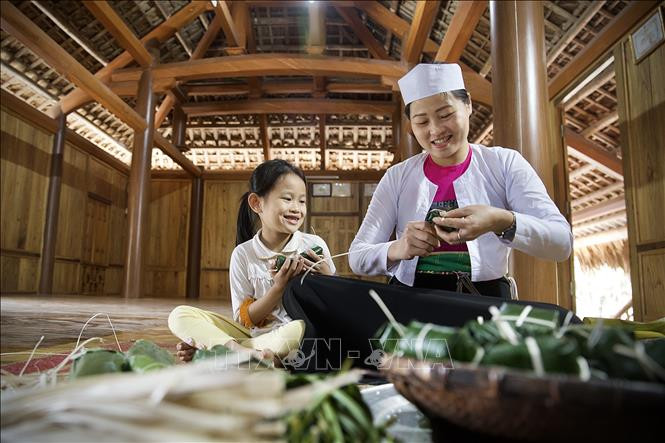Welcoming the New Year (Tet Nguyen Dan) is a beautiful, humane, long-standing cultural custom preserved by the Muong community in Hoa Binh for many generations.
This is the most important and biggest Tet holiday of the year for the Muong community in Hoa Binh.

The beauty of New Year customs
According to traditional beliefs, the Muong people in the four major Muong regions in Hoa Binh, including Muong Bi (Tan Lac), Muong Vang (Lac Son), Muong Thang (Cao Phong), and Muong Dong (Kim Boi), begin to celebrate the Lunar New Year (the Muong people call it New Year's Eve) from the 27th of the 12th lunar month of the old year to the 7th of the 1st lunar month of the new year.
From early morning on December 27, Muong people (Hoa Binh) have cut bamboo or young trees to strip and split into strips to wrap Chung cakes, make bars to grill meat... Every family must have a pole and it is planted right next to the entrance, in the yard or in front of the stilt house.
While splitting the strings to tie Chung cakes, Mrs. Bui Thi Dam, Hop Phong commune, Cao Phong district, recounted: “Planting a Neu tree is an ancient custom during Tet holidays of the Muong people. The elders said that when King Hoang Ba went to fight the demons, the demons were defeated and ran away. Following the instructions of King Hoang Ba, every household planted a Neu tree to announce the victory and receive land for the Muong people. Later, planting a Neu tree had the meaning of announcing to the earth and sky about the existence of one’s family and also to prevent evil spirits from entering the house.”
On December 28, the Muong people (Hoa Binh) start wrapping Chung cakes and Ong cakes. On December 29 according to the Muong calendar, they have a cooked rice meal, equivalent to a New Year's Eve meal, eaten in the evening, a family reunion meal of the year like the Kinh people. This is an important and sacred meal to see off the old year and prepare to welcome the new year. All the delicious and strange foods that the Muong people have prepared throughout the year are prepared for this meal.
Muong people welcome New Year's Eve with the joyful sound of gongs and drums. From the elderly to the children, they will go to the spring to get water and place it on the ancestral altar. Each Muong region has a different name for this activity. Muong Dong Kim Boi region calls it Fairy water, Muong Vang Lac Son region calls it Thang Thien water... Muong Bi Tan Lac region has the custom of washing hair, some people even bathe on New Year's Eve as a way to wash away everything so that in the new year everything will be better, more beautiful and luckier.
An important ritual on New Year's Eve of the Muong people is the outdoor worship ceremony. The offering tray includes a crucian carp and a rice cake. In the morning, the offerings are brought to the buffalo to eat first, because they believe that "the buffalo is the head of the family's fortune", feeding the buffalo first will make it strong enough to go to work.
On the altar during the New Year, the Muong people of Hoa Binh display a tray of five fruits, with two sugarcanes placed on both sides, symbolizing that the ancestors can lean on their canes to return to their descendants, leading the ancestors’ souls from heaven to the earth. The offering tray includes boiled chicken, banh chung, banh ong, wine, sticky rice, boiled meat, a bowl of water, betel and areca nuts, fish sauce, salt, etc., arranged on a piece of banana leaf cut into a circle, similar to the leaf trays that the Muong people often make during family festivals and ceremonies.
The Muong people's Tet holiday has always included Chung cake and Ong cake, symbolizing the round sky and square earth; also to commemorate the king of the Muong people - King Lang. The number of Chung cakes made in a family will be determined by the number of people worshiped. During the three days of Tet, the Muong people only celebrate Father's Day, Mother's Day and Teacher's Day, worshiping the most important people in the community's beliefs here.
Researcher on Muong Hoa Binh culture, Bui Huy Vong said: “The Muong people's custom of ancestor worship is to worship their ancestors by name, not in general like other ethnic groups. Like the altar for their deceased grandparents, the Muong people arrange a separate tray, put on it 2 bowls of rice, 2 banh chung, banh ong, 2 pairs of chopsticks and food. ... This worship depends on each family, but at least they worship up to 3 generations. After 10 incense sticks, the descendants can ask to lower the ceremony.”
During Tet, the Muong Hoa Binh community still preserves a unique custom of the "trash distribution" group, which is similar to the Kinh people's custom of visiting houses to wish them a happy New Year.
The gong performance troupe consists of 6-12 people (previously, there were also young boys and girls who sang the gong chant). The leader of the gong troupe is the troupe leader. Wherever the troupe goes, they play the gong and gong chant. When they enter a house, the troupe leader sings songs wishing the family a happy new year, called "distributing trash", opening the water, wishing the homeowner's family good health, prosperity in the new year, and coolness like water... After that, the homeowner invites the gong troupe to drink a cup of spring wine.
Going out on New Year's Day, Muong people wear their most beautiful clothes. Women wear black skirts, ao phan of different colors but mainly white, with large waistbands woven with elegant patterns, white scarves on their heads, revealing a patterned bib inside. Little girls and boys in traditional costumes happily run after the Phuong Bua group to wish New Year's greetings. Muong people go out, enjoy the New Year together in the bustling sound of gongs, welcoming a peaceful and prosperous new year.
On the last day of the new year (January 7), 4 Muong regions simultaneously organize the Khai Ha Festival, also known as the "opening the gong and the order" Festival, the "going down to the fields" Festival... This is the biggest holiday of the Muong people in Hoa Binh, the first day of the new year when they start farming work.
Preserve and maintain unique cultures

The New Year customs of the Muong people have changed a lot. Many households in the four Muong regions of Hoa Binh have started to celebrate the Kitchen Gods' Festival, buying fish to release at home on the 23rd of the twelfth lunar month. The ancestor worship rituals in the New Year are simple and have largely disappeared. Typical folk games are still held during the New Year and there are also modern games from other regions to serve the sightseeing and tourism needs of domestic and foreign tourists.
Over time, along with the increasingly developing market economy, the Muong ethnic identity and the “Hoa Binh Culture” are gradually fading away; the preservation, maintenance and promotion of Muong ethnic cultural values are urgent requirements. Hoa Binh province has been making efforts to preserve and promote the intangible and tangible cultural values of the Muong people and the “Hoa Binh Culture” in the area.
On November 24, 2023, Hoa Binh province issued the Project on Preserving and Promoting the Cultural Values of the Muong Ethnic Group and the "Hoa Binh Culture" in the period of 2023-2030 to continue researching, preserving and promoting the values of cultural heritages and fine traditions of the Muong people; contributing to promoting and introducing the land and people of Hoa Binh, building unique tourism products to attract domestic and international tourists, promoting the socio-economic development of the province. Mr. Luu Huy Linh, Deputy Director of the Department of Culture, Sports and Tourism of Hoa Binh province, said that the New Year celebration of the Muong people is a beautiful custom, containing many historical and cultural values from ancient times, preserved and passed down by the Muong people of Hoa Binh through generations. With the strong development of information technology, construction works and means of transport developing strongly, moving between regions has become easier, so preserving and maintaining the cultural values of the Muong people of Hoa Binh during each Tet holiday and Spring is urgent, requiring the synchronous participation of the entire system of departments and branches of the province.
During a recent working trip to Hoa Binh province, Head of the Central Propaganda Department Nguyen Trong Nghia emphasized that Hoa Binh needs to proactively and actively integrate into the international culture, strengthen the development of foreign culture; continue to promote the value of two great cultural heritages, Mo Muong and "Hoa Binh Culture" to research, compile documents, and submit to UNESCO for inclusion in the World Cultural Heritage List. The task of preserving and promoting the values of national culture, tangible and intangible culture of ethnic minorities plays a key role in the work of building and developing culture and people, meeting the requirements of rapid and sustainable development. This is a task that is both urgent and strategic and long-term.